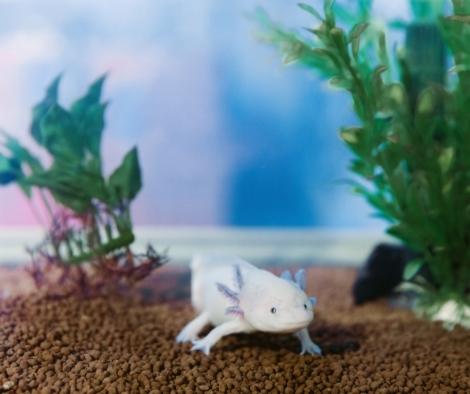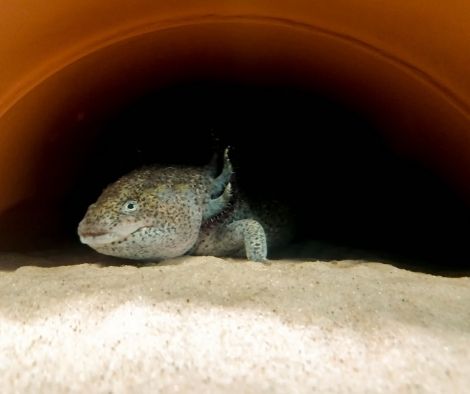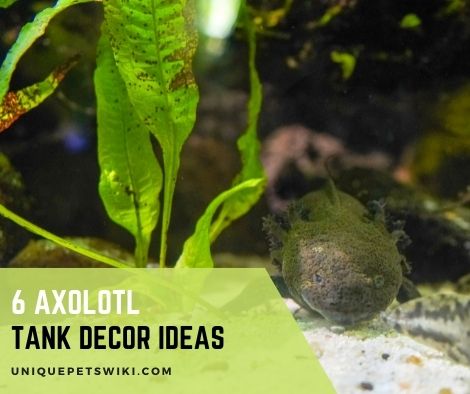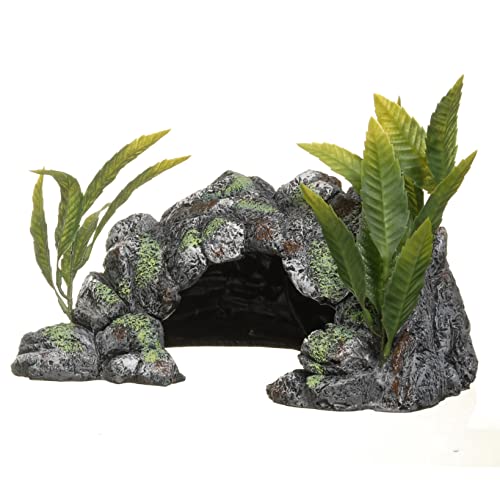While axolotls are pretty easy to care for, it’s important to be careful about the way you decorate your axolotl’s tank. Ideally, the environment in the tank should mimic the natural habitat of axolotls.
When it comes to decorating an axolotl tank, more is not better. Many axolotl owners put too much staff in the tank, reducing the space for the animal.
In this post, we are going to provide six tank decor ideas. Hopefully this post will help you understand what is good for your little friend and what is not.
Contents
6 Axolotl Tank Decor Ideas

When decorating your axolotl’s tank, keep these six factors in mind: light, hides, substrates, plants, decorating stones, and tank mates. Keep the tank in a shady place. Axolotls like caves and rocks. Live plants are great, but be sure to choose cold water plants only.
To create some safe space for your little friend, you can add plastic decorations and pieces of driftwood. For axolotls, the best tank mates include other axolotls, guppy fish, zebra danios, and small shrimp.
For Lights
Axolotls are rather nocturnal animals that do not need a lot of light. They actually love shady corners. While light is not necessary for your axolotl, you may not want to keep the tank in a dark place, because you want to observe your little friend.
So, there should be some light in the room, but the light should not be dazzling. An Finnex Stingray LED Clip Light for Aquarium may be enough for this purpose. Just place the light on the top of the tank lid. This clip light costs only around $25, so it’s an affordable solution.
Finnex Stingray LED Clip Light for Aquarium, Black, (JL-C18)
- Hood Construction: Aluminum/Plastic
- Hood Length: 9.5 Inches
- Wattage: 4 Watts
- Power Cord Length: 47 Inches
- Cliplight Rim Allowance: Under 1.5cm
Last update on 2022-12-30 / Affiliate links / Images from Amazon Product Advertising API
For Substrates
You have to add a substrate only if your axolotl is adult. Substrates are not needed for juvenile axolotls. When choosing materials for your axolotl tank substrate, choose materials that make the tank environment seem natural.
Consider using large gravel, fine sand, or a mixture of both. For a dark axolotl, the color of the substrate should be light. And if you have a light colored axolotl, choose a substrate with a dark hue. It’s for the easy visibility of your little friend.
Before you choose a substrate, learn about the best substrates so that you can make an informed decision. Also, learn how to add substrates properly.
Baby axolotl can only have bare bottom until they’re at least 5-6 inches, then they can have extremely fine sand as they can pass it.
Stoney River White Aquatic Sand Freshwater and Marine Aquariums
- Will not affect PH
- Safe for use in freshwater aquariums
- Non-Toxic coating
Last update on 2022-12-29 / Affiliate links / Images from Amazon Product Advertising API
For Plants
Plants make your axolotl tank more appealing, but they have other benefits as well. Live plants produce oxygen and reduce the level of nitrogen in the tank. Thus they help maintain a healthy cycle of nitrogen.
Axolotls love resting on plants, so make sure you choose robust and solid plants. In some cases, you may also consider using both live and synthetic plants.
Java fern, Marimo moss ball, water lettuce, Amazon Frogbits and other floating plants, anubias, guppy grass, eludia, anacharis are some good plants for axolotl tanks. It’s important to choose cold water plants, because the axolotl is a cold water creature.
Place short plants in the front of your axolotl tank, and the tall ones to hide the tank’s filter tubes. Place the plants in such a way that the tank mimic’s the animal’s natural habitat.
For Hides

Not many hides and shelters are needed if the tank is in a room that receives very little light. If the room is bright, put more shelters in the tank. Dark corners in the tank serve as secondary shelters for axolotls. Make arrangements for a couple of dark corners. Your axolotl will choose one of them.
Axolotls are not capable of swimming backward, so you have to make sure that the hideout has an entrance and an exit. Also, the hideout must not have sharp edges, which can injure your little friend’s fragile skin.
Note that each axolotl needs at least two hiding places. You can choose two that are different in design and leave them spaced apart. Observe your pet, See which one they like better.
If you want to get a little bit creative, make hides for your axolotl. Yes, you can take it as a DIY project if you have some time.
Marina Decor Polyresin Cave, Large
- Decor cave for your aquarium
- Includes three Amazon sword plants
- Safe and non-toxic
- Natural and realistic appearance
- Measures 5.1-inch length by 11.4-inch width by 7.7-inch height
Last update on 2022-12-29 / Affiliate links / Images from Amazon Product Advertising API
For Driftwood, Stones or Pebbles
These things can make an axolotl tank look more natural. Apart from making the tank visually appealing, they contribute to your axolotl’s health and well-being. You can collect these items, but they may contain parasites. So, consider buying them.
Do not use limestones because they carry calcium carbonate, which can disrupt the tank’s nitrogen cycle. Clean other types of pebbles and stones thoroughly before you put them in the tank.
Also, avoid decorative items that are intended for saltwater tanks. Those items may contain substances that can change the pH levels of the water and alter the nitrogen cycle. Changes in water parameters can make your axolotl agitated or sick.
Feel free to add pebbles and stones, but make sure they are at least twice the size of your axolotl’s mouth. The animal may swallow small pebbles or stones, and that can cause impaction—a painful and fatal condition.
Anything smaller than that at the axolotl‘s head should not go into axolotl tank as they can accidentally eat it and become impacted.
When choosing pebbles, stones or driftwood, make sure their color is not similar to that of your axolotl. The color should contrast with your axolotl’s color.
Avoid putting too many decorative items in the tank. Just a few stones can make the tank visually appealing. Position them in places that are easily visible, so that you can see the axolotl when the animal lies on them.
While some axolotls like to rest on sand substrates, others prefer stones. Observe the behavior of your little friend and change the decorative items if needed.
2 Pieces Stackable Aquarium Decoration Rock Caves
Last update on 2022-12-28 / Affiliate links / Images from Amazon Product Advertising API
For Tankmates
As part of decorating your axolotl’s tank, consider adding tankmates for your axolotl. Axolotls are not social creatures and they don’t need buddies. Nevertheless, if you want to put other creatures in the tank, it’s important to be careful about your choice.
Make sure the tank mates you choose are safe for your axolotl, and your axolotl is safe for the tank mates. Choose creatures that live in cool water. Avoid tropical fish that live in water more than 68°F.
Other axolotls, white cloud mountain minnows, guppy fish, adult apple snails, zebra danios, and small shrimp are some good tank mates for axolotls.
Things to Avoid When Decorating Axolotl Tanks
Avoid 3 things when decorating an axolotl tank. First of all, avoid adding things that are not usually present in the natural habitat of axolotls. Steer clear of flowers and bright light.
Second, avoid decor things that may harm axolotls, such as glass flakes, floating beads, and carnivorous plants.
And third, do not use too many decorative items because they will take up space and cause stress to your axolotl. You don’t need to add lots of driftwood and plants, or 5 hiding places. They will also make it hard to spot your axolotl in the tank.
Final Words
We have shared some axolotls tank decor ideas, and hopefully you have found them helpful. Please be informed that the above are just some ideas. We encourage you to get creative and figure out other ways to decorate your little friend’s habitat.
The key is to keep the objective in mind. It all comes down to creating an ideal environment for the growth and well-being of your axolotl.




